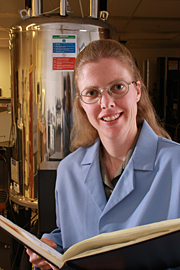- Number 315 |
- July 6, 2010
Following in nature’s footsteps

Dr. Wendy Shaw
At DOE’s Pacific Northwest National Laboratory, Dr. Wendy Shaw is learning the tricks behind the world’s best fuel-producing catalysts: enzymes found in plants and microbes. These enzymes produce hydrogen, which could be used to run cars, heat homes, or power remote outposts. By delving into the atomic nuances of the hydrogen-producing reactions driven by enzymes, Shaw is obtaining the information necessary to mimic natural catalysts in industrial settings.
“Mimicking nature is really hard and really humbling,” said Shaw.
Yet, the potential payoff is immense. This work could ultimately lead to catalysts that use earth-abundant nickel and iron, instead of exorbitantly priced platinum, to turn intermittent, hard-to-store sunlight or wind power into available, easy-to-store gas fuel or hydrogen.
“I’m doing basic research,” said Shaw, “that could have an impact on people’s lives some time very soon.”
While much work has been done on determining the paths electrons take in catalysts, Shaw is focusing on the less understood proton. Proton transport occurs throughout the enzyme, leading from the heart or active site of the catalyst to the edge or outer coordination sphere.
“For a long time, the outer coordination sphere of enzymes was considered ‘fluff,’” said Shaw. “But, what we are learning is that all of the extra fluff that enzymes have is worth something.”
Working with Dr. Dan DuBois and her colleagues at the Center for Molecular Electrocatalysis and Institute for Interfacial Catalysis, Shaw is determining how much of the outer coordination sphere needs to be reproduced to get the desired reaction rates.
This and other work resulted in Shaw winning a prestigious five-year DOE Early Career Research Program grant. Over the next half decade at PNNL and DOE’s EMSL, she will build catalysts by developing and attaching small proteins, called peptides, to already fast nickel-based catalysts. These peptides will be designed to transport protons to and from the catalyst’s active site. By mimicking some of nature’s proton transport features, she plans to greatly enhance the activity of these relatively simple catalysts. The knowledge she obtains could lead to bio-mimetic catalysts replacing platinum in fuel cells in the near future.
Throughout her career as well as her education, Shaw has benefited from generous teachers and mentors. She credits her love of science to her high school chemistry teacher Greg Goodnight at Kettle Falls High School. At PNNL, she started as a lab technician in 1994. She was mentored by Dr. James Franz. His sky-high scientific standards set the bar for Shaw and her research. He also taught her the value of asking basic scientific questions to solve real-world problems.
Today, Shaw works to pay back Franz and Goodnight, along with her other mentors, by instilling that passion for questions and thorough science in undergraduate students working at PNNL. She also devotes time and energy to educational demonstrations and projects with middle school and high school students, helping to inspire the next generation of scientists.
Submitted by DOE's Pacific Northwest National Laboratory
